Honda's F1 History
 By Phil Huff - February 4 2003
By Phil Huff - February 4 2003
Honda's rich and enviable heritage in the coveted Formula One World Championship spans the best part of 40 years. Yet Honda's earliest years of competition took place on two wheels rather than four.

Honda F1
Honda's rich and enviable heritage in the coveted Formula One World Championship spans the best part of 40 years. Yet Honda's earliest years of competition took place on two wheels rather than four.
Having already earned itself a reputation as a
world-class motorcycle manufacturer by achieving outstanding results in the
Isle of Man TT and other races, Honda was keen to develop passenger car
technologies through competition and started preparing for the challenges of
Formula One in the early 1960s.
The exciting project started to take shape in 1963 and by the end of the year Honda had fitted its experimental 1.5-litre RA270E to a steel-tube space frame chassis of its own design. This chassis had been built purely for testing, as Lotus had secured a deal to run the engine in the following year's championship.
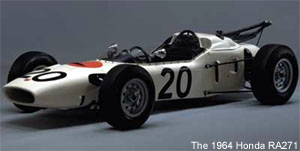 However,
in February 1964 the British team dropped out of the project forcing Honda
to choose between postponing its entry into F1 or operating its own engine,
chassis and race team. Encouraged by its early progress and willing to rise
to the titanic challenge, Honda determined to press ahead.
However,
in February 1964 the British team dropped out of the project forcing Honda
to choose between postponing its entry into F1 or operating its own engine,
chassis and race team. Encouraged by its early progress and willing to rise
to the titanic challenge, Honda determined to press ahead.
A new RA271E was prepared for the fast-approaching season together with an all-new state-of-the-art monocoque chassis constructed from aluminium panels. In an early example of technical ingenuity that would become the hallmark of all Honda's F1 engineering efforts, the load-bearing V12 engine was installed transversely into the chassis.
The first Honda F1 car made its Grand Prix debut on the daunting 22-kilometre Nürburgring circuit in early August with Ronnie Bucknum at the helm. The young American held a top ten position before being forced to retire with suspension damage. A month later Bucknum underlined the RA271's potency by running as high as fifth on the famously fast Monza circuit before overheating and braking problems interrupted progress up the leader board. Another non-finish was recorded in the American Grand Prix.
Learning the lessons gleaned from its first three Grands Prix in 1964, Honda's engineers laboured hard through the off-season to overcome their lack of four-wheeled racing experience. The team was eager to capitalise on the potential advantages afforded by the advanced RA271 engine which with a maximum horsepower of 230bhp was producing more than ten per cent greater power than any of its rivals.
To boost the team's chances of success, the experienced Richie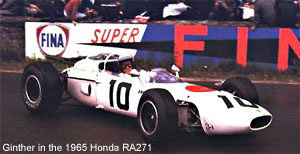 Ginther was signed to partner Bucknum in a two car attack. The Californian's
arrival started to produce results - Ginther scored Honda's first World
Championship point at Belgium's legendary Spa-Francorchamps circuit in June
and led both British and Dutch Grands Prix.
Ginther was signed to partner Bucknum in a two car attack. The Californian's
arrival started to produce results - Ginther scored Honda's first World
Championship point at Belgium's legendary Spa-Francorchamps circuit in June
and led both British and Dutch Grands Prix.
The final race of the season and of the 1.5-litre regulations was staged in Mexico - it was a landmark event for Honda too. Ginther grabbed the lead at the start and kept the opposition at bay to record Honda's maiden F1 victory on only its 11th outing. Adding to the celebrations, Bucknum finished a fine fifth.
Development of an all-new engine and chassis for the 1966 season began immediately after Honda's break-through F1 victory in Mexico. Having considered both V12 and V16 layouts to meet the new 3-litre regulations, Honda's engineers opted for the 12-cylinder alternative.
Once again the engine boasted more power than its rivals but the new machine was handicapped by being considerably overweight. Despite this Ginther ran second on its debut in Italy until a tyre burst and was looking good for a comfortable third in America before gearbox gremlins prevented a podium finish.
For 1967, Honda focused its energies on a single car entry for Englishman John Surtees - the only man ever to win World Championships on both two and four wheels. Surtees scored three top six points-scoring finishes in the first six races of the season before the sensational introduction of the brand new RA300 at Monza in September.
After an epic battle with Jim Clark (Lotus-Cosworth) and Jack Brabham (Brabham-Repco), Surtees surged through to record a famous victory by just two-tenths of a second. After the dramatic victory in its maiden race, Honda continued with the RA300 for the remainder of the 1967 season.
The company proved itself to be among the F1 elite by securing fourth place in the Constructors' Championship with Surtees also claiming fourth place in the Drivers' Championship. Based on these improving results, optimism ran high for Honda's fifth season on the Grand Prix grid.
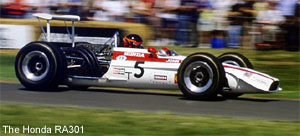 To
take the team to greater heights Honda developed a new chassis, the RA301.
The car featured a tougher, full-length monocoque and was considerably
lighter than its forebear thanks to the extensive use of magnesium. The
RA301's water-cooled V12 engine was extensively redesigned in the search for
greater power.
To
take the team to greater heights Honda developed a new chassis, the RA301.
The car featured a tougher, full-length monocoque and was considerably
lighter than its forebear thanks to the extensive use of magnesium. The
RA301's water-cooled V12 engine was extensively redesigned in the search for
greater power.
However despite proving more than a match for its rivals on several occasions, the RA301 was plagued by misfortune. Mechanical problems prevented top three finishes in Spain and Monaco before a suspension failure robbed Surtees of certain victory in Belgium.
The team had to wait until France to score its first points when Surtees finished second. The Englishman qualified on pole position (Honda's first) and led at Monza until crashing when avoiding a spinning car and led again at the season finale in Mexico until retiring with tyre problems.
Many of the problems in 1968 resulted from Honda's brave decision to pursue simultaneous development of two completely different cars. To help promote and market the company's new range of air-cooled road cars Honda instructed its engineers to design an air-cooled F1 engine. A V8 format was selected and a lightweight RA302 chassis was specially designed to meet the needs of the new air-cooled unit.
Honda's engineers were keen to banish their disappointments in the 1968 season and redress the balance in 1969. In August work started on an all-new car to be equipped with a lightweight and compact water-cooled V12.
However, within weeks, Honda announced its 'temporary withdrawal' from Grand Prix racing. The company's racing activities were to be put on hold for 15 years as Honda concentrated its efforts and resources on new challenges.
During its six-year adventure in Formula One, the company had grown unrecognisably as a producer of passenger cars and it was now preparing its plans to become a leader in the compact car market. Many of the skills absorbed from the original F1 programme would prove beneficial to the development of Honda's road cars throughout the years that followed.
Having established itself among the world's premier automotive manufacturers, Honda fulfilled its departing promise made in 1968 by re-entering Grand Prix racing in 1983. The prime mover behind the new project was Nobuhiko Kawamoto, whose sole objective was to capture the World Championships that had eluded Honda during the 1960s.
During the company's 15-year absence, however, the F1 world had evolved almost beyond recognition. Honda's return to F1 coincided with the zenith of the turbocharged era which superseded the 3-litre normally aspirated generation of Grand Prix cars that Honda and others had pioneered back in 1966.
During its first F1 programme, Honda had taken on the technical and financial burden of producing both engine and chassis in-house. By the time the company was evaluating a return to F1 in the early 1980s, there was the very attractive alternative of finding an established British race team to provide the chassis.
Honda gained confidence in the merging of Japanese and European racing cultures via a highly successful relationship with the Ralt Formula 2 team for whom Honda supplied 2-litre V6 engines. So, when the company officially announced its re-entry into F1 during the autumn in 1981, it was to be exclusively as an engine supplier.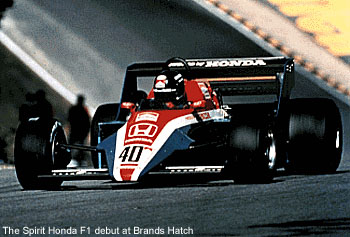
The prototype of Honda's first turbocharged F1 engine, designated RA163E, was installed in a modified Spirit F2 chassis. The hybrid ran for the first time at Silverstone in November 1982 heralding Honda's return to F1.
Following more development work, the Spirit-Honda made its debut in a non-championship F1 race at Brands Hatch in April 1983 and its full Grand Prix debut at the British Grand Prix in July. In the hands of Stefan Johansson, the car contested five further Grands Prix finishing seventh in Holland and showed enough promise for Honda to secure a contract to supply engines to the front-running Williams team.
To speed up development, a pair of Honda powered FW09s were hastily prepared for the final round of the season in South Africa and Keke Rosberg wasted no time proving the potential of the exciting new partnership. The Finn claimed fifth place to record Honda's first points of its second era in F1.
In 1984, Honda's technicians were faced with a new challenge as the F1 authorities introduced a fuel tank capacity limit of 220 litres along with a ban on mid-race refuelling. These stringent new regulations, aimed at constraining ultimate horsepower, forced engineers to marry efficiency with potency.
In order to gain a competitive edge, it became necessary for Honda's engine builders to decrease the weight of internal moving parts, to minimise frictional losses and to optimise fuel consumption through the use of ever more sophisticated electronic control systems.
For its first full season with Williams, Honda produced the RA164E - a heavily revised version of the RA163E. Despite some early problems largely associated with the enormously high temperatures produced by the forced induction, Rosberg scored Honda's first Grand Prix victory since 1967 on the streets of Dallas in the USA.
An all-new RA165E engine was introduced mid-way through the following season and immediately received positive reviews from Rosberg and team mate Nigel Mansell. The pair both claimed top six finishes on the new engine's debut in Canada and Rosberg took the chequered flag at the next Grand Prix in Detroit to record the second victory for a Honda turbo V6. Mansell and Rosberg won the final three races of the season to establish Williams-Honda as the team to beat in 1986 when Nelson Piquet would replace the Finn.
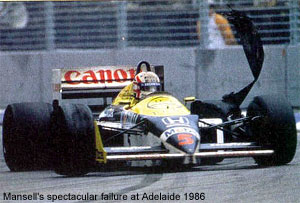 For
1986, a new RA166E engine was introduced to meet the demands imposed by a
further lowering of fuel tank capacity limit from 220 litres to 195 litres.
The new Williams-Honda FW11 dominated the championship with Mansell and
Piquet taking nine wins between them to secure the Constructors'
Championship for Williams-Honda with one round remaining. The Drivers'
Championship, however, eluded Honda when Mansell suffered a spectacular rear
tyre blow-out in the final race.
For
1986, a new RA166E engine was introduced to meet the demands imposed by a
further lowering of fuel tank capacity limit from 220 litres to 195 litres.
The new Williams-Honda FW11 dominated the championship with Mansell and
Piquet taking nine wins between them to secure the Constructors'
Championship for Williams-Honda with one round remaining. The Drivers'
Championship, however, eluded Honda when Mansell suffered a spectacular rear
tyre blow-out in the final race.
With the latest turbocharged engines now producing well in excess of 1000bhp (from just 1.5-litres), the sporting authorities sought to counter the ingenuity of F1 engine manufacturers by limiting boost pressure to 4 bar for the 1987 season.
This again forced Honda's technicians to seek new solutions... which they did successfully. With engines now being supplied to Lotus as well as Williams, Honda-powered cars took victory in 11 of the year's 16 races. The high point came at Silverstone where the Honda-powered cars of Mansell, Piquet, Ayrton Senna and Satoru Nakajima completed a 1-2-3-4 clean-sweep.
Piquet finally clinched the Drivers' Championship at the penultimate round at Suzuka, the first Japanese Grand Prix in a decade. The Brazilian's title was the first for a driver powered by a Honda engine and, at the same time, Honda had achieved its long-held ambition of victory in both the Drivers' and Constructors' World Championships.
Restrictions on turbocharged engines were further tightened for the 1988 season with boost pressure cut from 4 to 2.5 bar and fuel tank capacity reduced from 195 to 150 litres. With a new 3.5-litre normally aspirated formula due for introduction in 1989, Honda set-up a separate project to concentrate on the creation of a new 'atmo' engine. However, for 1988, Honda's engineers were determined to end the turbo era on a high note by competing with a new RA168E turbo engine designed to overcome the latest fuel-efficiency constraints.
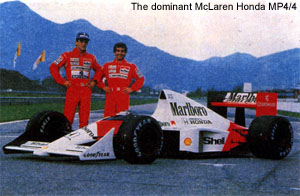 Having
ended its relationship with Williams at the end of 1987, Honda joined forces
with McLaren as well as remaining with Lotus for 1988. The first ever
McLaren-Honda - the MP4/4 - was an innovative machine and the new
combination's dominance was total. An almost perfect record established the
MP4/4 as the most successful car in F1 history.
Having
ended its relationship with Williams at the end of 1987, Honda joined forces
with McLaren as well as remaining with Lotus for 1988. The first ever
McLaren-Honda - the MP4/4 - was an innovative machine and the new
combination's dominance was total. An almost perfect record established the
MP4/4 as the most successful car in F1 history.
Between them, Alain Prost and Ayrton Senna won 15 of 16 rounds with the Brazilian finally clinching his first world title after an heroic season-long duel with his French team-mate. The McLaren-Honda team broke many records during the final season of the turbocharged era, scoring an unprecedented 199 points and recording no fewer than ten 1-2 finishes.
To meet the new-for-1989, 3.5-litre normally aspirated engine regulations, Honda designed a brand new RA109A V10 engine for reigning champions McLaren. Only Renault and Honda opted for the novel ten-cylinder configuration though others were soon to follow suit. McLaren prepared a new MP4/5 chassis and the formidable duo of Senna and Prost were once again contracted to drive.
Despite the challenging new regulations, McLaren-Honda's winning ways continued - the team won ten of 16 races with Prost taking the title. For the third consecutive year, Honda claimed both the Drivers' and Constructors' Championships.
Not wanting to sit on its laurels, Honda's renowned engineers incorporated many innovations into a new RA100E engine for 1990. With Prost leaving for Ferrari, Gerhard Berger lined up alongside Senna in a pair of revised MP4/5B chassis. Although Ferrari mounted a serious attack, the result was another successful campaign for Honda which saw Senna reclaim the Drivers' Championship and Honda take its fifth Constructors' Championship on the trot.
Honda's constant search for areas of possible improvement based on rigorous assessment of its own achievements and comparisons of its performance with that of its closest rivals, led the company to design a new V12 engine for McLaren in 1991. An upgraded version of the championship winning V10 would be provided to Tyrrell.
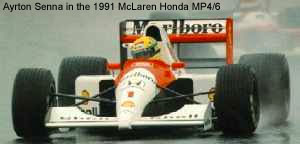 Badged
RA121E, the new V12 propelled McLaren's latest MP4/6 to victory in the
year's first four Grands Prix. In total Senna scored seven wins on the way
to his third Drivers' Championship with Honda in four years. With Berger
winning in Japan, Honda clinched the Constructors' Championship for the
sixth successive season.
Badged
RA121E, the new V12 propelled McLaren's latest MP4/6 to victory in the
year's first four Grands Prix. In total Senna scored seven wins on the way
to his third Drivers' Championship with Honda in four years. With Berger
winning in Japan, Honda clinched the Constructors' Championship for the
sixth successive season.
A major update of the RA121E engine was introduced for McLaren in 1992 but by now, Williams had gained a major competitive edge through the introduction of active suspension, coupled with a semi-automatic gearbox and other computer-controlled features.
Honda responded by increasing power but despite Senna winning three races and Berger two - including the season finale in Australia - for the first time since 1987 the World Championship would not be won by Honda power.
Long before the title had been lost, Honda's management had already taken the major decision that 1992 was to be the last year of Honda's second period of participation in Grand Prix racing. Berger's victory in Australia was the company's 71st win in the last race of Honda's second F1 adventure.
The third adventure has only just begun...
Courtesy of Honda Racing
The exciting project started to take shape in 1963 and by the end of the year Honda had fitted its experimental 1.5-litre RA270E to a steel-tube space frame chassis of its own design. This chassis had been built purely for testing, as Lotus had secured a deal to run the engine in the following year's championship.
 However,
in February 1964 the British team dropped out of the project forcing Honda
to choose between postponing its entry into F1 or operating its own engine,
chassis and race team. Encouraged by its early progress and willing to rise
to the titanic challenge, Honda determined to press ahead.
However,
in February 1964 the British team dropped out of the project forcing Honda
to choose between postponing its entry into F1 or operating its own engine,
chassis and race team. Encouraged by its early progress and willing to rise
to the titanic challenge, Honda determined to press ahead.A new RA271E was prepared for the fast-approaching season together with an all-new state-of-the-art monocoque chassis constructed from aluminium panels. In an early example of technical ingenuity that would become the hallmark of all Honda's F1 engineering efforts, the load-bearing V12 engine was installed transversely into the chassis.
The first Honda F1 car made its Grand Prix debut on the daunting 22-kilometre Nürburgring circuit in early August with Ronnie Bucknum at the helm. The young American held a top ten position before being forced to retire with suspension damage. A month later Bucknum underlined the RA271's potency by running as high as fifth on the famously fast Monza circuit before overheating and braking problems interrupted progress up the leader board. Another non-finish was recorded in the American Grand Prix.
Learning the lessons gleaned from its first three Grands Prix in 1964, Honda's engineers laboured hard through the off-season to overcome their lack of four-wheeled racing experience. The team was eager to capitalise on the potential advantages afforded by the advanced RA271 engine which with a maximum horsepower of 230bhp was producing more than ten per cent greater power than any of its rivals.
To boost the team's chances of success, the experienced Richie
 Ginther was signed to partner Bucknum in a two car attack. The Californian's
arrival started to produce results - Ginther scored Honda's first World
Championship point at Belgium's legendary Spa-Francorchamps circuit in June
and led both British and Dutch Grands Prix.
Ginther was signed to partner Bucknum in a two car attack. The Californian's
arrival started to produce results - Ginther scored Honda's first World
Championship point at Belgium's legendary Spa-Francorchamps circuit in June
and led both British and Dutch Grands Prix.The final race of the season and of the 1.5-litre regulations was staged in Mexico - it was a landmark event for Honda too. Ginther grabbed the lead at the start and kept the opposition at bay to record Honda's maiden F1 victory on only its 11th outing. Adding to the celebrations, Bucknum finished a fine fifth.
Development of an all-new engine and chassis for the 1966 season began immediately after Honda's break-through F1 victory in Mexico. Having considered both V12 and V16 layouts to meet the new 3-litre regulations, Honda's engineers opted for the 12-cylinder alternative.
Once again the engine boasted more power than its rivals but the new machine was handicapped by being considerably overweight. Despite this Ginther ran second on its debut in Italy until a tyre burst and was looking good for a comfortable third in America before gearbox gremlins prevented a podium finish.
For 1967, Honda focused its energies on a single car entry for Englishman John Surtees - the only man ever to win World Championships on both two and four wheels. Surtees scored three top six points-scoring finishes in the first six races of the season before the sensational introduction of the brand new RA300 at Monza in September.
After an epic battle with Jim Clark (Lotus-Cosworth) and Jack Brabham (Brabham-Repco), Surtees surged through to record a famous victory by just two-tenths of a second. After the dramatic victory in its maiden race, Honda continued with the RA300 for the remainder of the 1967 season.
The company proved itself to be among the F1 elite by securing fourth place in the Constructors' Championship with Surtees also claiming fourth place in the Drivers' Championship. Based on these improving results, optimism ran high for Honda's fifth season on the Grand Prix grid.
 To
take the team to greater heights Honda developed a new chassis, the RA301.
The car featured a tougher, full-length monocoque and was considerably
lighter than its forebear thanks to the extensive use of magnesium. The
RA301's water-cooled V12 engine was extensively redesigned in the search for
greater power.
To
take the team to greater heights Honda developed a new chassis, the RA301.
The car featured a tougher, full-length monocoque and was considerably
lighter than its forebear thanks to the extensive use of magnesium. The
RA301's water-cooled V12 engine was extensively redesigned in the search for
greater power.However despite proving more than a match for its rivals on several occasions, the RA301 was plagued by misfortune. Mechanical problems prevented top three finishes in Spain and Monaco before a suspension failure robbed Surtees of certain victory in Belgium.
The team had to wait until France to score its first points when Surtees finished second. The Englishman qualified on pole position (Honda's first) and led at Monza until crashing when avoiding a spinning car and led again at the season finale in Mexico until retiring with tyre problems.
Many of the problems in 1968 resulted from Honda's brave decision to pursue simultaneous development of two completely different cars. To help promote and market the company's new range of air-cooled road cars Honda instructed its engineers to design an air-cooled F1 engine. A V8 format was selected and a lightweight RA302 chassis was specially designed to meet the needs of the new air-cooled unit.
Honda's engineers were keen to banish their disappointments in the 1968 season and redress the balance in 1969. In August work started on an all-new car to be equipped with a lightweight and compact water-cooled V12.
However, within weeks, Honda announced its 'temporary withdrawal' from Grand Prix racing. The company's racing activities were to be put on hold for 15 years as Honda concentrated its efforts and resources on new challenges.
During its six-year adventure in Formula One, the company had grown unrecognisably as a producer of passenger cars and it was now preparing its plans to become a leader in the compact car market. Many of the skills absorbed from the original F1 programme would prove beneficial to the development of Honda's road cars throughout the years that followed.
Having established itself among the world's premier automotive manufacturers, Honda fulfilled its departing promise made in 1968 by re-entering Grand Prix racing in 1983. The prime mover behind the new project was Nobuhiko Kawamoto, whose sole objective was to capture the World Championships that had eluded Honda during the 1960s.
During the company's 15-year absence, however, the F1 world had evolved almost beyond recognition. Honda's return to F1 coincided with the zenith of the turbocharged era which superseded the 3-litre normally aspirated generation of Grand Prix cars that Honda and others had pioneered back in 1966.
During its first F1 programme, Honda had taken on the technical and financial burden of producing both engine and chassis in-house. By the time the company was evaluating a return to F1 in the early 1980s, there was the very attractive alternative of finding an established British race team to provide the chassis.
Honda gained confidence in the merging of Japanese and European racing cultures via a highly successful relationship with the Ralt Formula 2 team for whom Honda supplied 2-litre V6 engines. So, when the company officially announced its re-entry into F1 during the autumn in 1981, it was to be exclusively as an engine supplier.

The prototype of Honda's first turbocharged F1 engine, designated RA163E, was installed in a modified Spirit F2 chassis. The hybrid ran for the first time at Silverstone in November 1982 heralding Honda's return to F1.
Following more development work, the Spirit-Honda made its debut in a non-championship F1 race at Brands Hatch in April 1983 and its full Grand Prix debut at the British Grand Prix in July. In the hands of Stefan Johansson, the car contested five further Grands Prix finishing seventh in Holland and showed enough promise for Honda to secure a contract to supply engines to the front-running Williams team.
To speed up development, a pair of Honda powered FW09s were hastily prepared for the final round of the season in South Africa and Keke Rosberg wasted no time proving the potential of the exciting new partnership. The Finn claimed fifth place to record Honda's first points of its second era in F1.
In 1984, Honda's technicians were faced with a new challenge as the F1 authorities introduced a fuel tank capacity limit of 220 litres along with a ban on mid-race refuelling. These stringent new regulations, aimed at constraining ultimate horsepower, forced engineers to marry efficiency with potency.
In order to gain a competitive edge, it became necessary for Honda's engine builders to decrease the weight of internal moving parts, to minimise frictional losses and to optimise fuel consumption through the use of ever more sophisticated electronic control systems.
For its first full season with Williams, Honda produced the RA164E - a heavily revised version of the RA163E. Despite some early problems largely associated with the enormously high temperatures produced by the forced induction, Rosberg scored Honda's first Grand Prix victory since 1967 on the streets of Dallas in the USA.
An all-new RA165E engine was introduced mid-way through the following season and immediately received positive reviews from Rosberg and team mate Nigel Mansell. The pair both claimed top six finishes on the new engine's debut in Canada and Rosberg took the chequered flag at the next Grand Prix in Detroit to record the second victory for a Honda turbo V6. Mansell and Rosberg won the final three races of the season to establish Williams-Honda as the team to beat in 1986 when Nelson Piquet would replace the Finn.
 For
1986, a new RA166E engine was introduced to meet the demands imposed by a
further lowering of fuel tank capacity limit from 220 litres to 195 litres.
The new Williams-Honda FW11 dominated the championship with Mansell and
Piquet taking nine wins between them to secure the Constructors'
Championship for Williams-Honda with one round remaining. The Drivers'
Championship, however, eluded Honda when Mansell suffered a spectacular rear
tyre blow-out in the final race.
For
1986, a new RA166E engine was introduced to meet the demands imposed by a
further lowering of fuel tank capacity limit from 220 litres to 195 litres.
The new Williams-Honda FW11 dominated the championship with Mansell and
Piquet taking nine wins between them to secure the Constructors'
Championship for Williams-Honda with one round remaining. The Drivers'
Championship, however, eluded Honda when Mansell suffered a spectacular rear
tyre blow-out in the final race.With the latest turbocharged engines now producing well in excess of 1000bhp (from just 1.5-litres), the sporting authorities sought to counter the ingenuity of F1 engine manufacturers by limiting boost pressure to 4 bar for the 1987 season.
This again forced Honda's technicians to seek new solutions... which they did successfully. With engines now being supplied to Lotus as well as Williams, Honda-powered cars took victory in 11 of the year's 16 races. The high point came at Silverstone where the Honda-powered cars of Mansell, Piquet, Ayrton Senna and Satoru Nakajima completed a 1-2-3-4 clean-sweep.
Piquet finally clinched the Drivers' Championship at the penultimate round at Suzuka, the first Japanese Grand Prix in a decade. The Brazilian's title was the first for a driver powered by a Honda engine and, at the same time, Honda had achieved its long-held ambition of victory in both the Drivers' and Constructors' World Championships.
Restrictions on turbocharged engines were further tightened for the 1988 season with boost pressure cut from 4 to 2.5 bar and fuel tank capacity reduced from 195 to 150 litres. With a new 3.5-litre normally aspirated formula due for introduction in 1989, Honda set-up a separate project to concentrate on the creation of a new 'atmo' engine. However, for 1988, Honda's engineers were determined to end the turbo era on a high note by competing with a new RA168E turbo engine designed to overcome the latest fuel-efficiency constraints.
 Having
ended its relationship with Williams at the end of 1987, Honda joined forces
with McLaren as well as remaining with Lotus for 1988. The first ever
McLaren-Honda - the MP4/4 - was an innovative machine and the new
combination's dominance was total. An almost perfect record established the
MP4/4 as the most successful car in F1 history.
Having
ended its relationship with Williams at the end of 1987, Honda joined forces
with McLaren as well as remaining with Lotus for 1988. The first ever
McLaren-Honda - the MP4/4 - was an innovative machine and the new
combination's dominance was total. An almost perfect record established the
MP4/4 as the most successful car in F1 history.Between them, Alain Prost and Ayrton Senna won 15 of 16 rounds with the Brazilian finally clinching his first world title after an heroic season-long duel with his French team-mate. The McLaren-Honda team broke many records during the final season of the turbocharged era, scoring an unprecedented 199 points and recording no fewer than ten 1-2 finishes.
To meet the new-for-1989, 3.5-litre normally aspirated engine regulations, Honda designed a brand new RA109A V10 engine for reigning champions McLaren. Only Renault and Honda opted for the novel ten-cylinder configuration though others were soon to follow suit. McLaren prepared a new MP4/5 chassis and the formidable duo of Senna and Prost were once again contracted to drive.
Despite the challenging new regulations, McLaren-Honda's winning ways continued - the team won ten of 16 races with Prost taking the title. For the third consecutive year, Honda claimed both the Drivers' and Constructors' Championships.
Not wanting to sit on its laurels, Honda's renowned engineers incorporated many innovations into a new RA100E engine for 1990. With Prost leaving for Ferrari, Gerhard Berger lined up alongside Senna in a pair of revised MP4/5B chassis. Although Ferrari mounted a serious attack, the result was another successful campaign for Honda which saw Senna reclaim the Drivers' Championship and Honda take its fifth Constructors' Championship on the trot.
Honda's constant search for areas of possible improvement based on rigorous assessment of its own achievements and comparisons of its performance with that of its closest rivals, led the company to design a new V12 engine for McLaren in 1991. An upgraded version of the championship winning V10 would be provided to Tyrrell.
 Badged
RA121E, the new V12 propelled McLaren's latest MP4/6 to victory in the
year's first four Grands Prix. In total Senna scored seven wins on the way
to his third Drivers' Championship with Honda in four years. With Berger
winning in Japan, Honda clinched the Constructors' Championship for the
sixth successive season.
Badged
RA121E, the new V12 propelled McLaren's latest MP4/6 to victory in the
year's first four Grands Prix. In total Senna scored seven wins on the way
to his third Drivers' Championship with Honda in four years. With Berger
winning in Japan, Honda clinched the Constructors' Championship for the
sixth successive season.A major update of the RA121E engine was introduced for McLaren in 1992 but by now, Williams had gained a major competitive edge through the introduction of active suspension, coupled with a semi-automatic gearbox and other computer-controlled features.
Honda responded by increasing power but despite Senna winning three races and Berger two - including the season finale in Australia - for the first time since 1987 the World Championship would not be won by Honda power.
Long before the title had been lost, Honda's management had already taken the major decision that 1992 was to be the last year of Honda's second period of participation in Grand Prix racing. Berger's victory in Australia was the company's 71st win in the last race of Honda's second F1 adventure.
The third adventure has only just begun...
Courtesy of Honda Racing